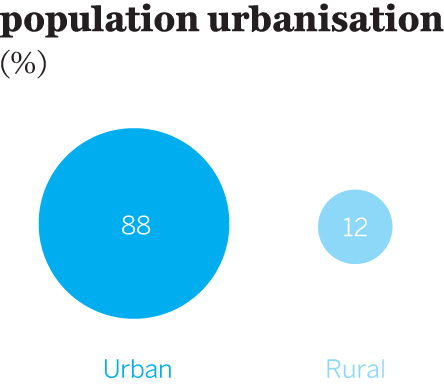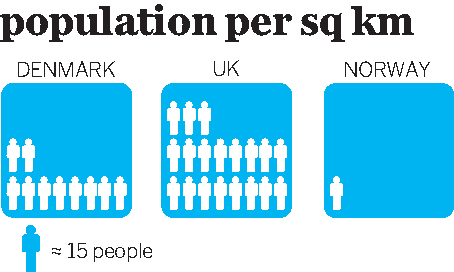Denmark Today
The Danes are, overwhelmingly, a happy bunch. If you believe the contentment surveys and liveability lists, Denmark is among the happiest nations on earth, enjoying some of the best quality of life. It’s not hard to see why: it has among the highest per-capita GDPs in the EU and unemployment is relatively low. Education is free, work–life balance is paramount, and Danish social-welfare programs are the envy of many (just ask Bernie Sanders). Plus: Danes know how to hygge (be cosy)!
Happiness & Harmony?
There is more to the Danes’ story of contentment. Stroll around almost any Danish town and you’ll experience some of the most harmonious civic spaces anywhere. Look a bit closer, however, and (as in a Hans Christian Andersen fable) you’ll find a darker side, too. As with other European nations, there’s been a gradual shift to the political right in this famously liberal nation. Concern has grown over immigration – particularly from Muslim countries – and an erosion of traditional values.
For all the talk of assimilation and the comprehensive state effort to achieve it, racial, cultural and religious fault lines and prejudices remain. This challenge to tolerance has unnerved many Danes; many of them avoid confronting their underlying resentment towards non-European newcomers. In mid-2015 the issue was highlighted when the anti-immigration, anti-EU Danish People's Party (DPP) won 21% of the vote at the general election, becoming the second-largest party in the parliament. Pollsters had notably underestimated the party's support – possibly due to some voters' reluctance to openly admit their backing of DPP policies.
Politics & Economics
Danish politics is a complex, multiparty beast, and there is a long tradition of minority governments and consensus politics (watch the Borgen TV series for a fictional primer). As of the 2015 elections, nine parties are represented in parliament; government is formed by coalition.
The political pendulum swung right in the most recent general election, held in 2015 amid concerns over immigration and the government's tough economic reforms. After one term in power, the left-leaning coalition led by Social Democrat Helle Thorning-Schmidt (Denmark's first female prime minister) was ousted and a centre-right coalition took its place. Denmark's current prime minister is Lars Løkke Rasmussen, who was PM before Thorning-Schmidt won power in 2011. Time will tell if the pendulum swings again at the next election (due by June 2019).
What is not under dispute is that the DPP is a growing force, winning 21% of the vote in 2015 (almost doubling its support from 2011). Many voters in udkantsdanmark (the sparsely populated, 'peripheral' areas of the country) feel the answers to their problems lie in the DPP's policies, as opposed to Social Democrat promises. As in other Nordic countries, populist parties like the DPP frame the choice for voters as agreeing to high immigration levels or protecting the welfare system (with the subtext of 'taking care of our own').
Sustainability
As well as their admirable attitudes to civic duties (voter turnout at the last parliamentary election was around 86%; there is relatively low tax evasion), Danes operate with a green conscience.
While some Western governments continue to debate the veracity of climate-change science, Denmark gets on with innovative, sustainable business. Check out State of Green (the country's 'green brand'; www.stateofgreen.com) for insight into how it's doing this.
Wind power generates around 40% of Denmark’s total energy consumption, and the country is a market leader in wind-power technology. The long-term goal for Danish energy policy is clear: the entire energy supply is to be independent of fossil fuels by 2050. The city of Copenhagen has pledged to go carbon-neutral by 2025; the capital has already reduced its carbon emissions by more than 40% since 1990 while its population has grown by 50%.
Cycling culture is another example of Denmark's green outlook. Copenhagen has around 400km of continuous, safe cycle paths, and in 2016 the number of bikes actually surpassed the number of cars in the city centre. The cycling infrastructure continues to expand, and more cities are seeking to learn from the bike-friendly master.
Best on Film
Babette's Feast (1987) Set in a rugged west-coast village in 1871. Setting the gold standard for food films to follow.
Pelle the Conqueror (1987) Award-winning depiction of the life of an immigrant in 19th-century Denmark.
Festen (The Celebration; 1998) The first of the Dogme95 movies, from celebrated writer-director Thomas Vinterberg.
In a Better World (2010) Playground bullying, conflicting moral choices – engineered to question the cosy stereotype of Denmark.
A Royal Affair (2012) A mad king, a young queen, an illicit affair. Period drama based on a true story.
Best in Print
The Complete Fairy Tales (Hans Christian Andersen; 1874) The most famous Danish book in the world.
Either/Or (Søren Kierkegaard; 1843) By the father of existentialism.
Miss Smilla's Feeling for Snow (Peter Høeg; 1992) A worldwide hit set largely in Copenhagen.
The Year of Living Danishly (Helen Russell; 2015) A Brit discovers the secrets of Danish life.
We, the Drowned (Carsten Jensen; 2006) An epic tale of sailors from seafaring Marstal on Æro.
Urban versus Rural
Copenhagen's population is expected to increase by 15% in the coming decade, according to Danmarks Statistik, placing pressure on the city's infrastructure and affordability. Meanwhile, there is much marginalising talk about the so-called udkantsdanmark. A negative press has portrayed these as rådne banan ('rotten banana') regions, home to poor, poorly educated and/or unemployed folks. To prevent a growing geographical class division, the government has started to relocate a number of government agencies (and 4000 jobs since 2015) out of the capital to regional centres.
Area
43,094 sq km
GDP
US$46,600 per capita
Coastline
7314km
Highest Point
Møllehøj 171m
Unemployment
4.2%
Population
5.761 million


